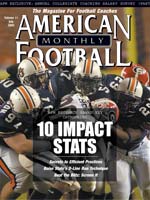Take Advantage of the Blitz... Screen It
Head Football Coach
Colorado School of Mines©
More from this issue
The Colorado
School of Mines football program has earned the reputation for relying
on the forward pass to move the ball offensively. Over the past
four seasons, we have averaged 322.1 passing yards a game. The success
that we’ve had throwing the ball has increased the amount of
blitzes we see from the defense.
We needed to develop other phases of our offense to make the blitz
a high-risk endeavor for the opposing defenses. Two phases we felt
could help accomplish this were to add more option plays to our
running game and improve the execution of screen passes.
The addition of option has helped increase our run production from
71.1 yards per game in 2000 to 163.5 yards per game in 2004. The
ability to successfully run the ball has kept us in normal second
and third down situations and much less predictable for the defense.
Our three screens, (F), (X), and (Z) gave us an answer to aggressive
blitzing teams that had continually given us problems. In 2004,
we completed 35 of 39 screen passes and averaged 14 yards per catch
while scoring 7 touchdowns. Our offense began to look at the blitz
as an opportunity to attack the defense rather than being intimidated.
We feel the most important keys to executing successful screen passes
are:
• Good timing.
• Simple and consistent scheme versus
different defensive configurations.
• Proper angle of departure by blockers.
We focus on these 3 keys during our daily screen period in a walk-through
setting against a scout defense.
F-SCREEN
Wide Receiver screens have always been a consistent part of our
offense, but we were not very successful executing a running back
screen. During the spring of 2004, we dedicated a five-minute daily
period only to the F-Screen. The extra time spent on the F-Screen
paid off in 2004 when we completed 15 of 18 attempts averaging 19.9
yards per catch and scoring 4 touchdowns. (See Diagrams 1 and
2)
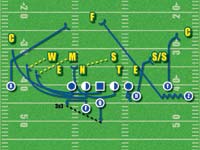
Diagram 1.
|
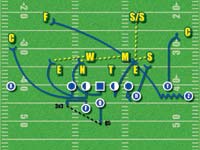
Diagram 2. |
The F-Screen Rules:
Play-side Tackle - Pass set for two counts, release flat
and block the “Will” linebacker.
Play-side Guard - Pass set for two counts. If the “Will”
linebacker is outside the tackle box, release flat and block the
“Mike” linebacker. If the “Will” linebacker
is inside the tackle the tackle box, release flat and block the
corner.
Center - Pass set for two counts. If the “Will”
linebacker is outside the tackle box, release flat and block the
corner. If “Will” linebacker is inside the tackle box,
release flat and block the “Mike” linebacker.
Off-Guard - Pass set for two counts, release and block the
“Sam” linebacker.
Off-Tackle - Pass set inside and block the defensive end.
H-Back - Block the first man outside the tackle box.
X-Receiver - Block the deep safety.
Y-Receiver - Block the corner.
Z-Receiver - Motion toward the ball and block the play-side
safety.
F-Back - Delay the release for two counts and read the play-side
defensive end for the proper release. Set hard inside versus a perimeter
blitz forcing the defender outside before releasing. The ball should
be received at a point three yard deep and three yards outside the
original alignment of the play-side tackle. The F-Back always releases
turning away from the quarterback, expecting the ball over his outside
shoulder, and turning outside after the catch.
Quarterback - Take a quick five-step drop keeping your eyes
downfield. Deliver the ball on step #6 and #7 staying on the move.
Z-SCREEN
The Z-Screen gives us a play to combat the blitz coming from the
strong side of our 3 x 1 formation. It also gives us an opportunity
to get the ball in the hands of a “playmaker.” We completed
all nine of our Z-Screen attempts in 2004, averaging 12.7 yards
per completion and scoring three touchdowns. (See Diagrams 3
& 4)
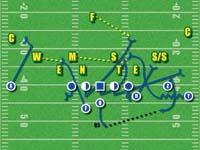
Diagram 3.
|
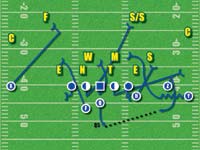
Diagram 4. |
The Z-Screen Rules:
Play-side Tackle - Pass set, give ground, and keep the widest
rusher's hands down.
Play-side Guard - Pass set for one count, release flat and
block the corner.
Center - Pass set for one count, release flat for the backside
linebacker.
Off-Guard - Pass set for one count, release flat and block
the play-side deep safety.
Off-Tackle - Pass set man on.
H-Back - Block the first threat outside the tackle box.
X-Receiver - Block the backside safety versus a two-deep
safety look. Block the corner versus a single safety.
Y-Receiver - Motion toward the ball and block the first linebacker
inside the tackle box.
Z-Receiver - Widen your alignment and release vertically
for three very quick steps. Retrace your steps and receive the ball
behind the line of scrimmage moving towards the quarterback.
F-Back - Block the first man outside the tackle box.
Quarterback (Right Handed) - Take a five-step drop with the
first three steps looking downfield. When throwing right, step #4
moves you on a slight angle to the target and the ball is delivered
on step #5 staying on the move away from the line of scrimmage.
When throwing left, open the left hip to the target with step #4
and deliver the ball as step #5 closes the right hip. Your momentum
will take you away from the line of scrimmage.
X-SCREEN
The X-Screen is used when we anticipate a blitz from the single
receiver side of our 3 x 1 formation or we want to get the ball
to our fastest receiver. We completed 11 of 12 X-Screens in 2004
and averaged 7.0 yards per catch. (See Diagrams 5 and 6)
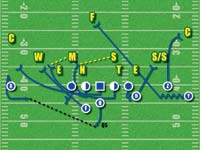
Diagram 5.
|
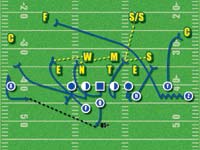
Diagram 6. |
The X-Screen Rules:
Play-side Tackle - Pass set, give ground, and keep the widest
rusher’s hands down.
Play-side Guard - Pass set for one count. If the “Will”
linebacker is outside the tackle box, release flat and block the
“mike linebacker. If the “Will” linebacker is inside
the tackle box, release flat and block the corner.
Center - Pass set for one count. If the “Will”
linebacker is outside the tackle box, release flat and block the
corner. If “Will” linebacker is inside the tackle box,
release flat and block the “Mike” linebacker.
Off-Guard - Pass set for one count, release on proper angle
to block “Sam” linebacker.
Off-Tackle - Pass set inside and block the defensive end.
H-Back - Block first man outside tackle box.
X-Receiver - Widen your alignment and release vertically
for three very quick steps.
Retrace your steps and receive the ball behind the line of scrimmage
moving towards the quarterback.
Y-Receiver - Motion toward the ball and block play-side deep
safety.
Z-Receiver - Block the backside corner.
F-Back - Block the “Will” linebacker.
Quarterback - Take a five-step drop with the first three
steps looking downfield. When throwing right, step #4 moves you
on a slight angle to the target and the ball is delivered on step
#5 staying on the move away from the line of scrimmage. When throwing
left, open the left hip to target with step #4 and deliver the ball
as step #5 closes the right hip. Your momentum will take you away
from the line of scrimmage.
The first and second units will get one rep of each screen against
the scout defense until both units have faced every defense we anticipate
seeing in the upcoming game. I will verbally count aloud “one
thousand one, one thousand two, release” on the F-Screen and
“one thousand one, release” on the X and Z Screens to
coordinate the timing of the play. We also use cones as landmarks
to ensure the offensive linemen are releasing flat on the proper
angles and the running back and wide receivers are consistently
receiving the ball in the correct area.
Although you may run only a few screens each game, how well you
execute your screen passes will have a big impact on how aggressive
the defense chooses to be. Taking the time each practice to drill
your screen package will pay huge dividends on game day.
About the author
Bob Stitt
Bob Stitt begins his sixth season as head coach of the Colorado
School of Mines this fall. Last season Stitt led the Orediggers
to the best year in school history as the team won its first
Rocky Mountain Athletic Conference title since 1958. The team
completed the regular season undefeated (11-0) but lost in the
second round of the Division II playoffs. The 2004 campaign
was the fourth straight winning season at Mines, a feat that
had not been accomplished since 1912-15. A Doane College (Neb.)
graduate, Stitt previously served as offensive coordinator at
Harvard.
Questions?
If you have any questions you can email the author at:
bstitt@mines.edu
|
